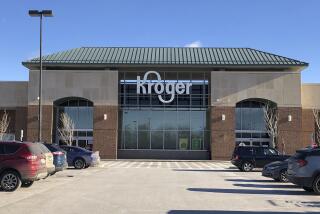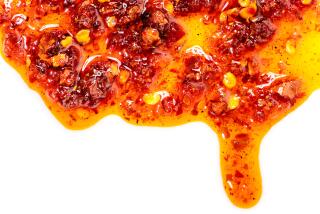Battle Over Shelf Space Heating Up for Makers of Premium Ice Cream
This summer may be hot, but it promises to be even hotter in the supermarket dairy cases. Lured by the success of Haagen-Dazs, the super premium ice cream, ice cream companies are now battling one another for customers and for space in the frozen food cases.
Supermarket retailers say a large number of East Coast brands--large and small--have recently joined the fray. âIt seems like they just discovered thereâs a market out here,â says Richard Yates, the frozen food and dairy buyer for Gelsonâs, an Encino specialty food store chain.
In 1980, just two premium ice cream brands--Dreyerâs Grand Ice Cream and Haagen-Dazs--were widely available here. Now, at least 23 brands--many from outside California--crowd supermarket frozen food cases.
There are so many brands, in fact, that some ice cream companies are already finding themselves frozen out. Harland Polk, vice president for sales at Hughes Supermarkets, says the premium ice cream market is near the the saturation point. âThere will be some fallout,â he says.
Especially vulnerable are regional California brands that lack the marketing muscle of such food industry giants as Nestle, Pillsbury and Kraft, all of which have entered the premium market recently.
âI like to say that David only had to fight Goliath once,â says James McCoy, president of privately held McConnellâs Ice Cream of Santa Barbara. âWe have to fight him every day.â
Itâs the prospect of profits that draws many companies to the premium ice cream market. Premium ice cream sales have increased by 20% a year since 1983, according to Find/SVP, a New York market research firm. Sales should grow to $2.21 billion this year from $1.86 billion in 1985, the concern estimates. By 1990, sales of richer and more expensive ice cream should reach $3.4 million, Find/SVP says.
The success of premium ice cream brands has lured other frozen dessert makers to the upscale end of the market, including makers of non-dairy, soybean-based products. David Mintz, president of Tofu Time, the Rahway, N.J., maker of Tofutti, says the market has become increasingly competitive. âEveryone is trying to get into the act,â he said. âLast time I counted, we had about 50 competitors.â
Tofu Timeâs profits have suffered. For the first six months ending Feb. 1, Tofu Time reported a loss of $119,787, compared to profits of $1 million a year earlier.
Premium ice cream contains more butterfat and less air than regular ice cream and is richer and more expensive than regular or economy brands. It generally retails for about $2 a pint, or $4 a quart, compared to $2 to $3 a quart for regular brands.
Yet retailers say that consumers seem willing to pay more for something that tastes good. âPeople are tired of belly-fillers,â says Gelsonâs Yates. He says premium ice creams hold special appeal to health-conscious consumers because they are low on chemicals and preservatives.
At the same time, consumer buying habits have changed, according to retailers. âIt used to be that consumers would buy a half-gallon of ice cream for the family,â says John Turley, frozen food buyer for Vons, the El Monte supermarket chain. âNow they buy a half-gallon for the kids and a gourmet brand for themselves.â
Out-of-state ice cream companies say Southern California is an especially attractive market because it has few regional brands. Whatâs more, Southern Californians may be ready for more ice cream since they now eat 15% less than other Americans despite a balmy climate.
âWe think ice cream hasnât been marketed properly in Southern California,â says Robert E. Baker, director of frozen desert marketing for Kraft, which has recently launched a major campaign to promote its Breyers ice cream, the leading East Coast brand.
Kraft plans a costly television and radio advertising blitz--something thatâs relatively new to the industry. This year, ice cream makers will spend only $80 million advertising ice cream, says Jan Booth, marketing vice president for Oakland-based Dreyerâs Grand Ice Cream, the biggest selling premium in the West. âAdvertising costs are very low for the size of the market,â says Booth.
Ad Costs Rising
Those costs have escalated rapidly, however, as larger and better financed national food companies have entered the market. Five years ago, the ice cream industry spent just $8 million on advertising. Pillsbury, Kraft and others âlook at the market and say, âItâs a gold mine.â Itâs a real under-marketed category,â Booth says.
That means that advertising expenditures can go a long way. Industry experts say its no secret that the two largest selling super premiums are owned by giant food companies. Haagen-Dazs, which Pillsbury purchased three years ago, sold 45% of all super premium ice cream last year, while Kraftâs Frusen Gladje accounted for 10% of the sales, according to A. C. Nielson, the market research firm.
Smaller companies lack big advertising budgets and so rely more on satisfied customers to spread their names around. An inability to support its product was one reason why Double Rainbow, a privately owned San Francisco brand, recently lost its only Southern California supermarket account, Boys Markets. Owner Steve Fink says that âwe canât offer volume discounts that Haagen-Dazs and Frusen Gladje can offer.â
âItâs like having to fight a sea of battleships in a rowboat,â says Terry Walsh, sales manager for San Gabriel-based Tartufo Ice Cream, which manufacturers an Italian gelato. Yet Tartufo, with $2.7 million in sales last year, has managed to sell its product in Chicago, New York and several other metropolitan markets. âWe offer something different,â Walsh says. âWeâre one of the few successful gelatos out there.â
Lukewarm Reception
Itâs not just the smaller companies that have marketing headaches, however. Despite its ad blitz, Breyersâ reception in Southern California has been lukewarm. Albertsonâs now stocks it, but Hughes, Vons and Ralphs have all decided to pass on it, at least for now. âItâs not as good as we were led to believe,â says Polk, Hughes sales vice president.
âAny time you enter a market, itâs going to be difficult,â says Kraftâs Baker. âBut not insurmountable.â
Tres Chocolat, a rich chocolate ice cream that Dreyerâs markets (it recently sold the name to Haagen-Dazs), has disappeared from a number of supermarket cases. Two weeks ago, Vons decided not to sell it after a four-month trail. Paul R. Woodland, Dreyerâs financial vice president, said the product continues to do well in smaller specialty stores.
One brand that has done well is Steveâs, a Lindenhurst, N.Y., brand that is partly owned by Richard Smith, who developed Frusen Gladje, which he sold to Pillsbury last year. Industry marketing executives credit Smithâs marketing prowess for Steveâs fast acceptance.
âRichie Smith is probably the best marketing man in the ice cream business,â says Walsh, Tartufoâs sales manager. âHe knows how to cut a deal. Everyone has a hot button to push, and somehow he finds it.â
Smith says he plans coupons and television ads for the brandâs introduction to Southern California, âbut you have to have a good product,â he insists. âA lot of your sales come from world of mouth.â
Retailers say Steveâs, which got its start in a Boston ice cream parlor and contains bits of candy and cookies, has found a place in the frozen food cases because it is different from most other premiums.
âIts name is home-grown American, and the pieces of candy and fruit make it different from the other European-sounding brands,â says Al Maresca, marketing vice president at Compton-based Ralphs.
Although the market is becoming saturated, he said, thereâs still room for distinctive new products like Steveâs. âThe market is at its peak,â Maresca said, âan all-time high. And I expect it will continue.â
More to Read
Inside the business of entertainment
The Wide Shot brings you news, analysis and insights on everything from streaming wars to production â and what it all means for the future.
You may occasionally receive promotional content from the Los Angeles Times.










